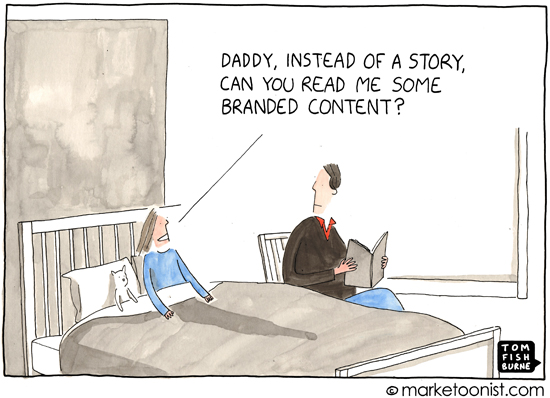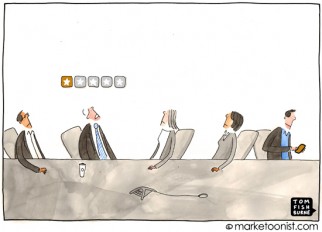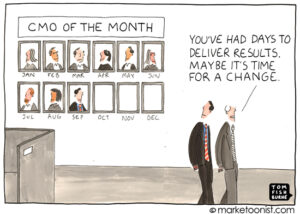One of the takeaways from Advertising Week in New York last week is the rise of “branded content”. Brands are embracing the potential of branded content to blur the lines between advertising and entertainment. It seems like every week, I hear the expression, “Content is King”.
It’s true that content marketing holds great promise, as marketers start to create communication that is genuinely worth sharing. Yet, in creating content, we should remember that consumers don’t necessarily want “content”. They want stories. “Branded content” and “content marketing” is insider terminology used by marketers. It’s up to marketers to make the content into something more meaningful.
In the branded content bandwagon, there is too often an emphasis on quantity over quality. Content is treated like a commodity. Consumers can see many forms of “branded content” a mile a way, and it’s only a matter of time before they learn to tune it out as readily as other forms of advertising.
That is, unless we create content that is truly meaningful to the audiences we are trying to reach.
Joe Pulizzi from the Content Marketing Marketing Institute wrote an interesting article recently on the poor quality of most branded content:
“The majority of content produced by brands through blog posts, enewsletters, social media posts, print magazines and webinars is flat out awful. In many cases, the content is self-serving, not useful and, maybe the worst, pointless. Even when you ask marketers themselves, just one in three believe that the content they develop is effective.”
He goes on to write that branded content frequently lacks strategy, focus, and accountability, three factors that can hobble the impact of content marketing.
I’d love to hear your stories of brands that are getting branded content right and wrong.
(Marketoonist Monday: I’m giving away a signed print of this week’s cartoon. Just share an insightful comment to this week’s post by 5:00 PST on Monday. Thanks!)



Jonas Holmström says
Ahoy! We’re a destination marketing organization promoting a small island and we’re about to start a club for children. One of the things we’re planning is to provide provide some “branded content” in the form of e-books. This cartoon is sport on, just the way I imagine children should ask for our e-book. Feels a bit creepy when thinking about it like branded content. But hey! The club is called the Pirate Club! .-) Arrr!
Erik Jan says
Great cartoon! However, my six year old son keeps asking me for ‘branded content’ since we went to the Red Bull Framed Reactions event in Amsterdam. Lots of videos, a huge poster, he’s really into it. And he recognizes the Red Bull-logo everywhere now… Not that he knows that it is branded content, but he doesn’t consider it as advertising (which he ‘hates’).
Jess Culbert says
I think Joe Pulizzi makes a good point, but I’d separate social media posts from the other platforms listed. Blogs, print and webinars must have a clear defined purpose (most of the time). But by its very nature content posted to Facebook or Twitter (for example) will be more frequent and vary in type. Let’s not take ourselves so seriously that we can’t say ‘hello. Monday here again’ once in a while on Twitter! Even the big brands make good use of social media small talk very well.
Simon Sanders says
Getting ‘quality’ right is what matters most. Not quantity.
Sounds obvious, but it can be a hard principle to hold on to, when agencies and clients are beholden to a content calendar that attempts to map out tweets, blogs, infographics, downloads, videos to fill every channel, all times of day, as well as all manner of generic seasonal opportunities and potential reactive opportunities. Strategy is core – but it needn’t be over complicated. The best work is always that which strengthens the brand – how the end user feels about the brand. In many cases, the content is inconsequential, or self-serving and not rewarding the time invested in it, and has a nil effect at best in terms of communication or branding.
katie moffat says
Most of the problem stems from the fact that marketeers start with the premise of ‘what messages do I want to get across’ rather than ‘what is my audience really interested in and how can I align that with our content’. Really good content takes time and effort to get right and at the moment very little organisations seem to truly commit the resource to get it right.
Love the cartoon!
Ann Handley says
So true, Tom.
But I have a more sanguine view of branded content lately. At least, some of it.
Chipotle’s “The Scarecrow” is fantastic. So is Airbnb’s “Hollywood & Vine,” which is such a gorgeous bit of marketing content that it’s essentially art.
But probably my favorite story is one told by Congressional candidate Carl Sciortino called “Father’s Son.” It’s the best political “marketing” I’ve ever seen, and I’m not exaggerating! http://www.annhandley.com/2013/09/20/the-best-political-ad-ever/
As someone wise says, “The best marketing doesn’t feel like marketing.” 🙂
Henry says
The best examples are when the content IS the brand IS the story.
Think about Red Bull (tired but true!): from sport to music to stunts, they’re perfectly aligned across these three dimensions.
Ann Handley says
OOPS… inadvertently hit POST before I was done. Joe Pulizzi’s new book (Epic Content Marketing) also has many great examples of excellent branded content, including information produced by Open View Venture Partners, a VC company in my neck of the woods (Boston).
Jay Baer’s new(ish) Youtility book also has great examples of useful branded content and tools. (And now I really will stop commenting here.. LOL)
Mary L. Cole (@euonymous) says
Goodnight, Mooncakes.
🙂
James Perrin says
Really good post Tom, and so true. It’s one thing to think of content as a product, but for brands, and ultimately you’re brand’s audience it is much more than that. Joe hits the nail on the head perfectly, and for me it’s about finding the ideas that will work, and making them work by creating really useful/entertaining content. Creating content for the sake of it will get us nowhere.
Pauline Draper-Watts says
Love the cartoon this week. In part it comes back to objectives – what is the branded content seeking to do? Is it relevant to the target audience? Is it appropriate and is it timely? How does it reflect the brand? How engaging is it? Can it have legs with others talking about it and sharing it? When it is done well, it can be amazing, creative and highly engaging – but there are too many examples where quality (or lack of) is the slave of quantity with inferior storytelling (or no storytelling) mediocre graphics and poor execution. I love it when we get to test concepts and “big ideas” before they becomes reality so that we can refine them and ensure that they will hit the mark but I recognize that there is not always time and budget for this.
Katherine Kotaw says
Content may be king, but stories rule the kingdom. Content fills space in the same way porridge fills our tummies. But no one outside of a Dickens novel craves an extra helping of mushy brown cereal. Great stories never satisfy — they always leave us wanting more. Your cartoon makes this point succinctly, Tom, and makes me crave more of them!
Ori Pomerantz says
Again, capitalistic humility. Branding is what you want. Great content is what the customer wants. You care about the customer’s wishes, the customer does not have any reason to care about yours.
Attention is a limited resource. If you don’t offer good value for it, you can forget about getting any.
Jennifer Salkeld Nelson says
While I don’t disagree with Joe’s point that much of the content of content marketing lacks strategy, focus, and accountability; I think sometimes the opposite is true – that it’s creation ONLY includes the business’ own strategy and focus, and forgets the that the reader/viewer/recipient of content actually has to value the content for it not to be quickly dismissed as just more advertising (or worse, leave a negative sentiment behind as overly self-serving drivel often does). Bottom line: it has to be “good” – from the recipients point of view.
Here’s my advice: For a publisher, content actually has to be good enough that people want to pay for it. So if you are in the business of creating, evaluating or approving the creation of branded content, try holding it to that standard by asking yourself: Would someone actually pay for this?
Jarvis Emerald says
OOO. well put Katherine. Finally a forward looking response to this topic. I love that you gave the analogy of content filling the space…and left the surrounding free to interpretation. Yes, good point about good stories never satisfying. I’ll borrow that one. I hold the idea that the story is ongoing too. What I believe we mean by “Story” is the moral inherent in the contents presentation…and a well thought out presentation is far more useful than not.
Betsy Scuteri says
Paid, earned and owned media are taking an interesting shift so it is less about what the content actually is (sponsored or not) and more about if it appeals to the reader. It’s not about demographic targeting any longer, but about interest-based media and finding out what your audience really wants.
Joe has some good points about quantity output and it’s fairly simple. If you don’t deliver authentic, smart and engaging content, you won’t get anything in return.
Ted Simon says
Once again, Tom, you have nailed it in one, simple, pithy frame. Many other fine observations by commenters as well. I’ll add two-cents…
Bottom line, if a tactic is to be considered as part of the marketing discipline, then the discipline of marketing needs to be applied to that tactic. In this case, it’s strategic fundamentals such as understanding your customer/audience needs, wants, desires and providing them with information that is relevant and compelling to their lives and needs.
Joe Pulizzi’s quote is very apt for poor branded content. I would also say that his comments are also spot on for ANY form of marketing that is fails to apply such fundamental principals. Just substitute the words “tv commercial,” “print ad,” or “display ad” for “branded content”…the shoe fits. Which surprise none of us.
As the Bard himself said centuries ago: “A rose by any other name…”
Keep up the great stuff. Your cartoons make Mondays (almost) bearable!
Kristina Halvorson says
Someone just sent me a copy of this cartoon, and I immediately licensed it for future presentations. Thank you!
Jean Storlie says
I’ve used the same analogy about communicating health content as fact versus story (i.e.,”Mommy will you tell me some facts and science?)” Looking at how we communicate with children can help us thing about what matters to EVERYONE. Love the cartoon! Thanks Tom!
Richard Stacy says
Content is SO not king – information is now king – and that is something altogether different
http://richardstacy.com/2013/10/03/why-information-not-content-is-king-in-social-media/